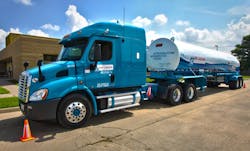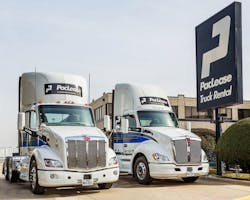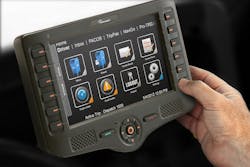Yet it’s not hard to fathom why: a safer truck – not to mention a safety-conscious driver – is far more likely to arrive at a destination on time, tractor and trailer undamaged, with its load intact. That’s how carriers make money and at the end of the day what helps carriers make money is what wins precious investment capital.
Scott Webb (seen above) with New Mexico-based Mesilla Valley Transportation (MVT) probably said it best during a presentation at the 2014 Technology & Maintenance Council annual meeting in Nashville, TN, this week: “We can’t have delivery failures or we won’t be in business.”
That sentiment is one of the reasons Air Liquide recently acquired 145 new highway tractors spec’d full of some of the latest and greatest safety technologies not only as part of a 5 year effort to revitalize its fleet but to provide its 500-plus bulk distribution drivers better with systems to help them react faster to unexpected road conditions while promoting safe driving habits.
[Click here to view a video walk-around of Air Liquide’s new trucks.]
Air Liquide – part of the Air Liquide Group, which spans 80 countries, employs 50,000 and serves more than 2 million customers and patients primarily via the manufacture and delivery of oxygen, nitrogen and hydrogen gases – is buying a mix of day cabs, single-sleeper cabs, and dual sleeper cabs equipped with the following systems:
- Advanced radar sensors mounted to the front and side of the tractor to detect the presence and movement of vehicles around the truck and to alert drivers of potential hazards in the truck’s intended path and in the drivers’ blind spot.
- Collision prevention technology that assists drivers in maintaining a safe following distance, and to help avoid and reduce the impact of rear-end collisions by activating the brakes in emergency situations when a driver may not have time to react.
- An air brake system that reduces stopping distance by 25 percent as compared to conventional brakes. Air brakes are fade-resistant, preventing degradation of stopping power.
- A stability control system that works in conjunction with the air brake system to help prevent rollovers by applying each wheel’s brakes in the correct sequence.
- A lane departure warning system that detects when a truck crosses the lane divider strips and triggers an audible alarm to alert the driver.
- An event recording system – complete with a dual-facing camera mounted on the windshield that captures 180 degrees in front of the vehicle and inside the cabin – the system detects and records unusual movements of a vehicle.
“Convincing the drivers to accept all this new technology can be a daunting task, but we are a company solidly committed to the strongest culture of safety,” Paul explained to me. “We make it clear that all this new technology is there to assist the driver with the ability to return home to their families and loved ones in the same condition they came to work in.”
He added that Air Liquide shares “success stories” at its monthly safety meetings to highlight how those technologies played roles in helping drivers avoid accidents or exonerating a driver in a non-preventable situation.
“The success of these implementations starts at the top and is then infused at all levels with the same message: SAFETY FIRST,” Paul wrote.
But it’s not just carriers involved in the transportation of potentially hazardous goods that are spec’ing more safety technologies on their trucks: even what you’d call “everyday” freight haulers are doing it.For example, take the “Technology Demonstration” trucks (seen at left) recently shown off by the Paccar Leasing Company at the Truck Rental and Leasing Association (TRALA) annual meeting this week in Scottsdale, AZ.
The Kenworth T680 and Peterbilt Model 579 pictures are both powered by Paccar MX-13 engines rated at 485-hp and mated to Eaton Ultra Shift Plus automated-manual transmissions (AMT).
“A recent survey of National Private Truck Council members showed increased interest in outfitting trucks with safety technology,” noted Michelle Harry, PacLease’s director of marketing, during a press event at TRALA.
Here are just some of the safety systems from suppliers such as Bendix and PeopleNet incorporated into these PacLease “demonstration” tractors:
- Air disc brakes, which reduce stopping distance by more than 20 feet over today’s high performance drum brakes;
- Bendix’s ESP electronic stability system for rollover and jackknife prevention;
- The Wingman Advanced collision mitigation technology, which detects objects up to 500 feet in front of the truck and provides braking intervention if needed;
- BlindSpotter side object detection, which provides audible and visual alerts if there is a vehicle in the truck’s blind spot;
- AutoVue lane departure, which tracks lane markings while providing a “rumble strip” noise should the vehicle drift off course;
- SmarTire tire pressure monitoring, which provides low pressure and high temperature tire alerts.
“In addition, the system provides real-time diagnostic information from all the Bendix technology,” stressed PacLease’s Harry. “The data generated from PacTrac and the Bendix safety systems are tied together [and] a report can then be generated to show driver performance, plus relay any situations where the Bendix systems triggered a driver alert.”
Once the TRALA conference is over, she said the two PacLease “demo” trucks will hit the road, joining another “technology” spec’d Kenworth T680 and Peterbilt Model 579 for week-long demonstrations at customer sites for much of 2014.
“The trucks have been utilized in fleet operations as demos since December,” Harry noted. “We know each customer is unique and has different needs, so we will work with their customers on custom spec’ing their trucks to their specific requirements that could include some or all of the technology we’re showcasing with our demo trucks.”
Yet another example of how ways to boost trucking safety continue to evolve in tandem with technology.




